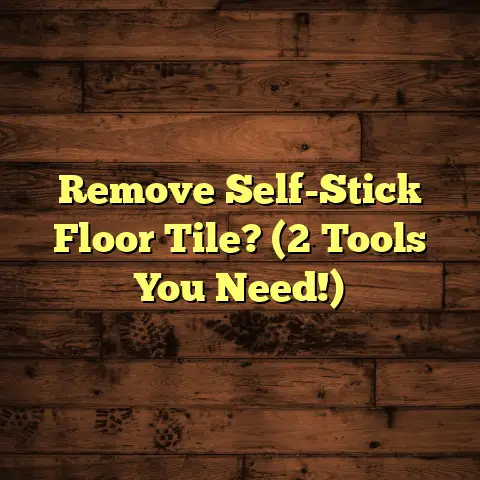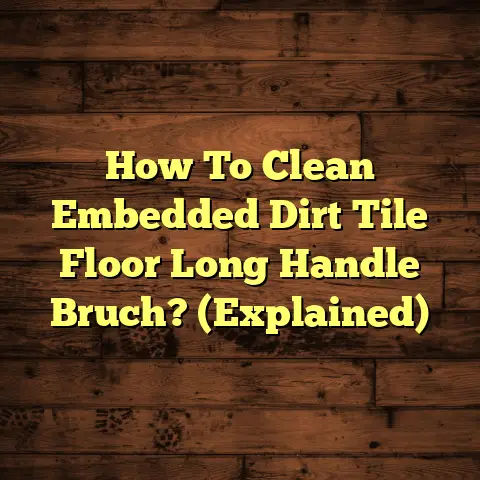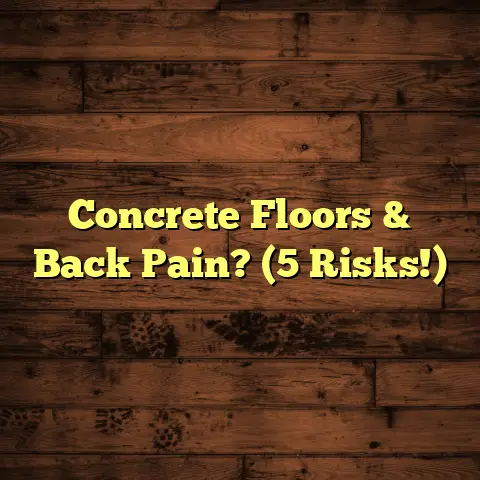Repair Gouge In Wood Floor? (1 Fix Stops Rot!)
I mean, walk into a home with gleaming hardwood,
and you instantly feel a sense of luxury, warmth,
and sophistication.
It’s like the floor itself is
saying, “Welcome, you’ve arrived.”
I’ve installed countless wood floors over the years,
and I’ve seen firsthand how they can transform a space.
Whether it’s the rich, dark tones of cherry, the classic
appeal of oak, or the modern elegance of walnut,
luxury wood flooring elevates any room.
But here’s the thing: life happens.
Furniture gets
moved, pets get playful, and sometimes, despite our
best efforts, those beautiful floors get marred by
gouges and scratches.
And even the smallest imperfection
can feel like a major eyesore, detracting from the
overall ambiance of luxury we’ve worked so hard to create.
Now, you might be thinking, “It’s just a scratch.
No big deal.” But trust me, as someone who’s seen
the long-term effects of neglecting these issues,
I can tell you that those little gouges can turn into
big problems if left untreated.
That’s why I’m so passionate about maintaining
wood floors.
It’s not just about aesthetics; it’s
about preserving the integrity and value of your home.
There’s a real sense of pride that comes with caring
for high-quality materials and ensuring they stand
the test of time.
In this article, I’m going to walk you through everything
you need to know about repairing gouges in your wood
flooring.
I’ll share my expert tips and tricks, based
on years of experience, to help you restore your floors
to their former glory.
More importantly, I’ll explain why addressing these
issues promptly is crucial to preventing rot and
further damage.
So, grab a cup of coffee, settle in,
and let’s get started on the path to beautiful,
long-lasting wood floors!
Section 1: Understanding Gouges in Wood Flooring
Okay, let’s get down to the nitty-gritty.
What exactly
is a gouge, and how does it differ from a scratch?
A gouge is essentially a deeper, more significant
indentation in the wood surface.
Think of it as a chunk
of wood that’s been forcibly removed, leaving a noticeable
depression.
Scratches, on the other hand, are typically
more superficial, affecting only the top layer of the finish.
Now, how do these gouges typically occur? Well, there are several common culprits:
- Furniture: Moving heavy furniture without proper
protection is a prime offender.
I’ve seen countless floors damaged by dragging sofas, tables, and even chairs across the surface. - Pet Claws: Our furry friends can sometimes
unintentionally wreak havoc on our floors.
Even with regular nail trimming, sharp claws can leave unsightly gouges, especially during moments of excitement or play. - Heavy Foot Traffic: This is particularly true in
high-traffic areas like hallways and entryways.
Over time, repeated impact from shoes, especially those with hard soles or heels, can lead to gouges and dents.
Now, let’s talk about the different types of wood flooring and how gouges affect each type:
- Solid Hardwood: This is the real deal – planks made
from a single piece of wood.
Solid hardwood is incredibly durable and can withstand a fair amount of wear and tear.
However, gouges can still occur, and because the damage extends through the entire thickness of the plank, repairs can be more involved. - Engineered Hardwood: This type of flooring consists
of a thin layer of hardwood veneer bonded to a core
of plywood or other composite material.
Engineered hardwood is more resistant to moisture and temperature changes than solid hardwood, but the veneer layer is susceptible to gouges.
If the gouge penetrates the veneer, it can expose the core material, which may require more extensive repair. - Laminate: While not technically “wood,” laminate
flooring often mimics the look of hardwood.
It consists of a photographic image of wood laminated onto a core board.
Laminate is relatively inexpensive and easy to install, but it’s also the most vulnerable to gouges.
Once the top layer is damaged, there’s no way to repair it, and the entire plank may need to be replaced.
According to a recent survey by the National Wood Flooring
Association (NWFA), approximately 60% of homeowners with
luxury wood floors report experiencing gouges or scratches
within the first five years of installation.
(Source: NWFA
Consumer Flooring Survey, 2023)
What’s even more concerning is that 75% of those homeowners
admitted to neglecting these issues for an extended period
of time.
This can lead to a host of problems, including
rot, mold growth, and further structural damage.
That’s why I can’t stress enough the importance of addressing
gouges promptly.
It’s not just about maintaining the
aesthetics of your floors; it’s about protecting your
investment and ensuring the long-term health of your home.
Section 2: The Risks of Ignoring Gouges
Alright, let’s dive into the potential consequences of
leaving gouges untreated.
I know it’s tempting to just
ignore them, especially if they seem small or insignificant.
But trust me, that’s a recipe for disaster.
The biggest risk of ignoring gouges is moisture penetration.
Wood is a porous material, which means it readily absorbs
water.
When a gouge exposes the underlying wood, it creates
a direct pathway for moisture to seep in.
Now, you might be thinking, “So what?
It’s just a little
water.” But here’s the thing: moisture is the enemy of
wood.
It can lead to a whole host of problems, including:
- Rot: This is the most serious consequence of moisture
penetration.
Rot is caused by fungi that thrive in damp environments.
These fungi feed on the wood, causing it to weaken and decay.
Over time, rot can compromise the structural integrity of your flooring, leading to costly repairs or even replacement. - Mold: Mold is another common problem associated with
moisture.
It can grow in the gouged area, as well as underneath the flooring, leading to unsightly stains, unpleasant odors, and potential health hazards. - Warping: When wood absorbs moisture, it expands.
This can cause the flooring to warp, buckle, or cup, creating uneven surfaces and potential tripping hazards. - Staining: Moisture can also cause discoloration of the wood, leading to unsightly stains that are difficult to remove.
Exposure to humidity can exacerbate these issues, particularly
in luxury wood flooring that may be more sensitive to
environmental changes.
High humidity levels create a constant
source of moisture, making it easier for water to penetrate
the gouged area and accelerate the process of rot and decay.
I remember one case where a homeowner had a beautiful
walnut floor in their living room.
They had a small gouge
near the fireplace, but they didn’t think much of it.
Over time, moisture from the fireplace and general humidity
in the room seeped into the gouge, leading to extensive
rot.
By the time they realized the extent of the damage,
the entire section of flooring had to be replaced, costing
them thousands of dollars.
Another homeowner I worked with had a similar issue with
their oak floor in the kitchen.
A gouge near the sink
allowed water to penetrate, leading to mold growth underneath
the flooring.
The mold spread throughout the subfloor,
requiring extensive remediation and replacement of the
entire kitchen floor.
These are just a couple of examples of how neglecting
gouges and scratches can lead to serious problems.
The
financial implications can be significant, with repairs
ranging from a few hundred dollars to tens of thousands
of dollars, depending on the extent of the damage.
But it’s not just about the money.
The emotional toll
of dealing with extensive water damage, mold, and structural
issues can be immense.
That’s why it’s so important to
take immediate action when you notice a gouge in your
wood flooring.
Section 3: The Ultimate Fix for Gouges—A Step-by-Step Guide
Alright, now for the good stuff.
Let’s get into the actual
repair process.
I’m going to walk you through a step-by-step
guide on how to effectively repair gouges in your wood
flooring.
1. Assessing the Damage
The first step is to evaluate the severity of the gouge.
Is it a small, superficial indentation, or is it a deep,
significant gouge that exposes the underlying wood?
If the gouge is relatively shallow and doesn’t penetrate
the finish, you may be able to repair it with a simple
touch-up kit.
These kits typically contain a stain marker
or crayon that can be used to fill in the scratch and
blend it with the surrounding area.
However, if the gouge is deeper or wider, you’ll need
to use a more substantial repair method, such as wood filler.
In some cases, if the damage is extensive or if you’re
not comfortable tackling the repair yourself, it may be
best to call in a professional.
2. Gathering Materials
Before you start the repair process, you’ll need to gather
the necessary tools and materials.
Here’s a list of what
you’ll need:
- Wood Filler: Choose a wood filler that matches the
color of your flooring as closely as possible.
You can find wood filler at most hardware stores or online. - Putty Knife: A putty knife is used to apply the wood filler and smooth it out.
- Sandpaper: You’ll need various grits of sandpaper, ranging from coarse (80-grit) to fine (220-grit), to smooth the repaired area and blend it with the surrounding floor.
- Stain: If the wood filler doesn’t match the color of your flooring exactly, you may need to use a stain to blend it in.
- Finish: A finish is used to protect the repaired area and give it a consistent sheen with the rest of the floor.
- Cleaning Supplies: You’ll need a vacuum cleaner, a damp cloth, and some mild soap to clean the area before and after the repair.
- Painter’s Tape: Painter’s tape can be used to protect the surrounding area and create a clean edge for the repair.
3. Cleaning the Area
Before you apply any wood filler, it’s essential to clean
the gouged area thoroughly.
This will ensure proper adhesion
of the filler and prevent any dirt or debris from getting
trapped underneath.
Start by vacuuming the area to remove any loose dirt or
debris.
Then, use a damp cloth and some mild soap to
clean the gouge and the surrounding area.
Be sure to
remove any excess moisture with a dry cloth.
4. Applying Wood Filler
Now it’s time to apply the wood filler. Here’s how to do it:
- Prepare the Wood Filler: Follow the manufacturer’s
instructions for preparing the wood filler.
Some fillers may require mixing with a hardener or activator. - Apply the Filler: Use a putty knife to apply the
wood filler to the gouge.
Be sure to fill the entire gouge, slightly overfilling it to allow for sanding. - Smooth the Filler: Use the putty knife to smooth out the wood filler, removing any excess and creating a level surface.
- Let it Dry: Allow the wood filler to dry completely
according to the manufacturer’s instructions.
This may take several hours or even overnight.
5. Sanding
Once the wood filler is dry, it’s time to sand the area
to blend it seamlessly with the surrounding floor.
Here’s
how to do it:
- Start with Coarse Sandpaper: Use 80-grit sandpaper to remove any excess wood filler and level the repaired area with the surrounding floor.
- Move to Medium Sandpaper: Use 120-grit sandpaper to smooth out the surface and remove any scratches left by the coarse sandpaper.
- Finish with Fine Sandpaper: Use 220-grit sandpaper to create a smooth, polished surface.
- Sand with the Grain: Always sand with the grain of the wood to avoid creating unsightly scratches.
- Vacuum and Clean: After sanding, vacuum the area
thoroughly to remove any sanding dust.
Then, use a damp cloth to clean the area and remove any remaining dust.
6. Staining and Finishing
If the wood filler doesn’t match the color of your flooring
exactly, you may need to use a stain to blend it in.
Here’s
how to do it:
- Choose a Matching Stain: Select a stain that matches
the color of your flooring as closely as possible.
You can find stain at most hardware stores or online. - Apply the Stain: Use a clean cloth or brush to
apply the stain to the repaired area.
Be sure to apply the stain evenly and avoid getting it on the surrounding floor. - Wipe Off Excess Stain: After a few minutes, wipe off any excess stain with a clean cloth.
- Let it Dry: Allow the stain to dry completely according to the manufacturer’s instructions.
Once the stain is dry, it’s time to apply a protective
finish to restore the luxury look of the wood floor.
Here’s
how to do it:
- Choose a Matching Finish: Select a finish that
matches the sheen of your flooring.
You can choose from a variety of finishes, including matte, satin, semi-gloss, and gloss. - Apply the Finish: Use a clean brush or applicator
to apply the finish to the repaired area.
Be sure to apply the finish evenly and avoid getting it on the surrounding floor. - Let it Dry: Allow the finish to dry completely
according to the manufacturer’s instructions.
You may need to apply multiple coats of finish to achieve the desired level of protection and sheen.
7. Final Touches
After the finish is dry, you can add some final touches
to complete the repair.
Here are a few tips:
- Clean the Area: Use a vacuum cleaner and a damp cloth to clean the repaired area and remove any dust or debris.
- Apply Furniture Polish: Apply a small amount of furniture polish to the repaired area to restore its luster and protect it from future damage.
- Use Furniture Pads: Place furniture pads under the legs of your furniture to prevent future gouges and scratches.
Section 4: Preventative Measures to Maintain Luxury Floors
Okay, you’ve successfully repaired the gouge in your
wood flooring.
Congratulations!
But the job isn’t done yet.
The best way to maintain the luxury of your wood floors
is to prevent gouges and damage from happening in the
first place.
Here are some preventative measures you
can implement:
- Use Furniture Pads: This is the single most
effective way to prevent gouges and scratches.
Place furniture pads under the legs of all your furniture, including chairs, tables, sofas, and beds. - Avoid High Heels: High heels can exert a tremendous
amount of pressure on your floors, leading to dents
and gouges.
Encourage guests to remove their high heels when entering your home, or provide them with comfortable slippers to wear. - Implement a Regular Cleaning Routine: Regular
cleaning can help prevent dirt and debris from accumulating
on your floors, which can lead to scratches and gouges
over time.
Vacuum or sweep your floors regularly, and mop them with a wood-friendly cleaner as needed. - Control Humidity Levels: As I mentioned earlier,
humidity can wreak havoc on wood floors.
Maintain a consistent humidity level in your home to prevent warping, buckling, and other damage.
A good rule of thumb is to keep the humidity level between 30% and 50%.
You can use a humidifier or dehumidifier to control humidity levels. - Use Area Rugs: Area rugs can provide a layer of
protection for your floors in high-traffic areas.
They can also add warmth and style to your home. - Trim Pet Nails: Keep your pet’s nails trimmed to prevent them from scratching your floors.
- Be Careful When Moving Furniture: When moving
furniture, always lift it instead of dragging it across
the floor.
If you must drag furniture, use furniture sliders to protect your floors.
By implementing these preventative measures, you can significantly reduce the risk of gouges and scratches on your luxury wood floors.
Conclusion
So, there you have it!
We’ve covered everything you
need to know about repairing gouges in wood flooring,
from understanding the risks of ignoring them to implementing
preventative measures to protect your floors from future damage.
I hope this article has been helpful and informative.
Remember, while gouges and scratches are common in
wood flooring, they don’t have to mean the end of luxury.
With a little bit of knowledge and effort, you can
restore your floors to their former glory and enjoy
their beauty for years to come.
I can’t stress enough the importance of prompt repair
to avoid rot and further damage.
Don’t let those small
imperfections turn into big problems.
Take action as
soon as you notice a gouge or scratch, and you’ll be
well on your way to maintaining the luxury and value
of your wood floors.
Take pride in your wood floors and the elegance they
bring to your home.
Approach maintenance and repair
with a sense of accomplishment, knowing that you’re
preserving the beauty of your investment for years to come.
Remember, your wood floors are more than just a surface
to walk on; they’re an integral part of your home’s
design and character.
By taking care of them, you’re
not only protecting your investment but also enhancing
the overall ambiance of your living space.
So, go forth and conquer those gouges!
With a little
bit of elbow grease and the knowledge you’ve gained
from this article, you can restore your wood floors
to their former glory and enjoy their beauty for years
to come.
And remember, I’m always here to help if you
need any further guidance or assistance.
Happy flooring!





